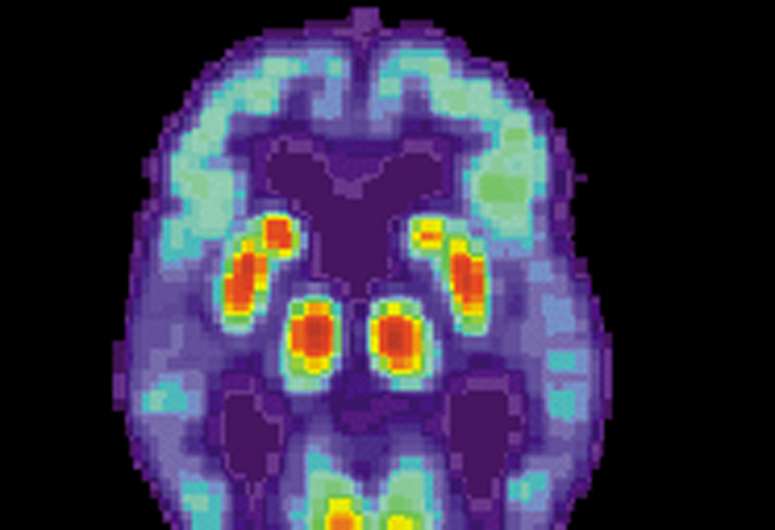PET scan of a human brain with Alzheimer's disease. Credit: public domain
Among the hallmarks of Alzheimer's disease are the Alzheimer fibrils, deposits of the tau protein, which accumulate in nerve cells in the form of fibres and disrupt communication between nerve cells. But how does this fibre formation take place? Why do such harmful deposits develop from the originally useful tau protein, which normally stabilizes cells? This question was addressed by a team of researchers from the University of Konstanz and Utrecht University (Netherlands), led by Konstanz chemist Professor Malte Drescher. Using structural analyses, the researchers brought to light a surprising biochemical mechanism in which a molecular chaperone—a helper protein—plays an unusual role. The research results are going to be published on 13 March 2020 in the journal Science Advances and are available as a preprint version at Biorxiv.
Unlike most other proteins, tau does not have a clearly defined structure: Tau is an intrinsically disordered protein that can take many shapes. "We can imagine it like a rope: it can be sometimes elongated, sometimes bent, sometimes looped," says Malte Drescher. Despite all the variance, tau tends to assume a characteristically recurved structure, comparable to the shape of a paper clip.
An unusual molecular chaperone
A peculiarity occurs as soon as the chaperone HSP-90 (Heat Shock Protein 90) encounters tau. "Normally, it is the job of chaperones to bring newly produced proteins into the correct form. Thus, they exert a helper function in the development of protein structure. We were wondering: What might their helper function be in an intrinsically disordered protein such as tau?" says Drescher.
Using structural analyses, Drescher and his team were able to show that the chaperone causes the paper clip conformation of tau to open: It folds the "brackets" of the paper clip outwards. "The area in the middle of the paper clip is thus exposed and made accessible. This area is known to be responsible for aggregation, i.e., for attachment of further tau proteins to the molecule," explains biophysicist Sabrina Weickert, lead author of the study and a doctoral researcher under Malte Drescher's supervision. In their unfolded form, tau molecules can therefore be stacked on top of each other with a perfect fit (oligomerization).
"This oligomerization by HSP-90 came as a big surprise," explains Malte Drescher: "A chaperone is actually responsible for exactly the opposite: It is supposed to bring a protein into a defined form and under no circumstances contribute to the formation of a 'protein pile,'" says Drescher.
Responsible for Alzheimer's or secretly a defence mechanism?
Is the presence of the chaperone thus a prerequisite for the formation of Alzheimer fibrils? Is the chaperone, of all molecules, ultimately the one that causes the development of Alzheimer's disease? The researchers will pursue this question in further studies. However, Malte Drescher suspects precisely the opposite: "I would argue exactly the other way round: It could even be a trick the body does to prevent Alzheimer's," Drescher says. The tau oligomers produced by HSP-90 have one crucial peculiarity: They do not continue to grow to form the typical pronounced Alzheimer fibrils.
"The oligomerization by HSP-90 might possibly be a defence mechanism in which the chaperone forces the tau proteins into the form of small oligomer layers. Although this is not advantageous, it effectively prevents formation of longer, Alzheimer-typical fibrils," Drescher suggests. Should this assumption prove true, the chaperone would fulfil its stated purpose: In this case, it would prevent the development of long Alzheimer fibrils by making a gambit and binding tau into smaller, less dangerous stacks.
Spin labels
The tau protein is only a few nanometres in size, i.e. a billionth of a metre, and is not visible to the naked eye or light microscopes. Otherwise typical experiments for structure determination such as X-ray structure analysis fail, because tau as an intrinsically disordered protein is so extremely flexible. In order to determine the structural changes of the protein anyway, the researchers therefore resorted to a sophisticated method: They attached tiny probe molecules, "spin labels," to key positions of the molecule, including the outer "brackets" of the paper clip conformation. "The probes are magnetic and sense each other. We measure the interaction between the probes and can thus determine the distance between their positions," explains Malte Drescher. In this way, they can indirectly detect the conformation of the molecule and its structural changes.
The series of experiments took place in vitro, with purified tau and HSP-90 molecules in the test tube. "We now want to bring the experiment into the cell in order to observe the biochemical mechanism under the real-world conditions inside a cell," says Malte Drescher, giving an outlook on future research work. The long-term goal is to better understand the development of Alzheimer's disease and to find methods to prevent it.
More information: Sabrina Weickert et al, The molecular mechanism of Hsp90-induced oligomerization of Tau, (2019). DOI: 10.1101/614289
The molecular mechanism of Hsp90-induced oligomerization of Tau, Science Advances (2020). advances.sciencemag.org/content/6/11/eaax6999
Journal information: Science Advances
Provided by University of Konstanz























